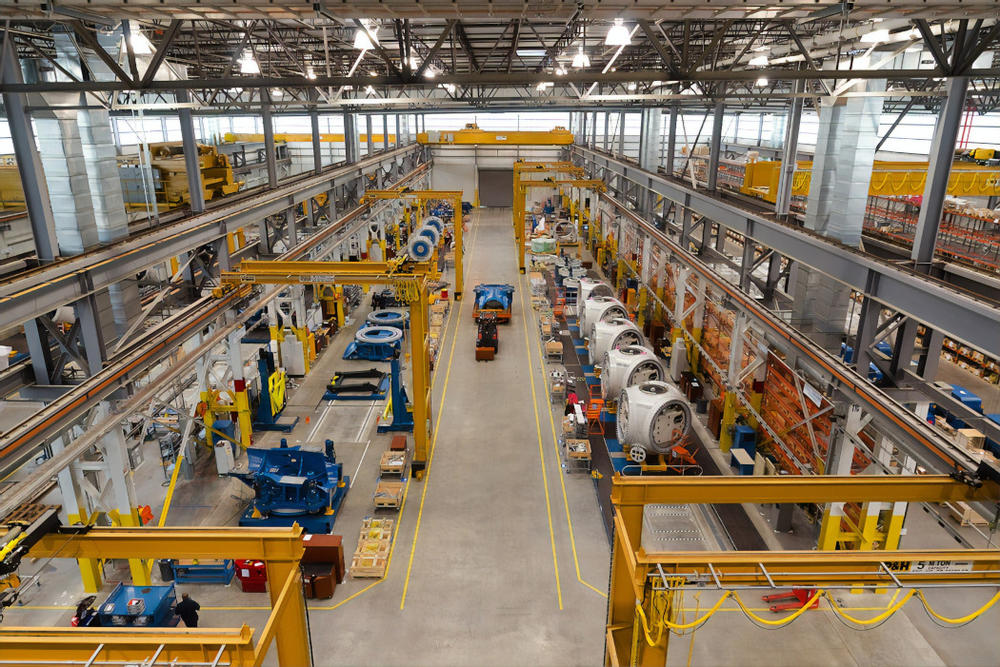Automation and Economic Growth
by Aaron Benanav
№ 34/2021 from Jun 29, 2021
Today, automation technologies are said to be moving from the factory to the office. Algorithms consulted via cloud computing may soon displace lawyers, radiologists, stock brokers, and even managers from their jobs. In his blog post, Aaron Benanav raises the question which consequences present-day technologies will have for liberal societies.
Americans wind manufacturing - Nordex USA manufacturing facility
Image Credit: Science in HD (Unsplash)
Seen from one perspective, the advent of advanced robotics and artificial intelligence would represent a major success for liberal societies. The economy would grow quickly. More people would be able to meet their needs and fulfill their dreams without taking away from others’ capacities to do the same. At the same time, talk of automation has generated anxieties about the future of employment. A key aspect of liberalism is self-responsibility: people are expected to earn money, set budgets, and stay within those limits. Work becoming less available would pose a challenge to this core liberal principle. A basic income is sometimes proposed as an alternative to unemployment assistance under conditions of a rapidly automating economy. For example, society could provide each adult with a monthly income of 1,000 EUR, with no conditions attached to these earnings. Even classical liberals like Milton Friedman have argued in favor of a negative income tax, which is a form of basic income. How should a society experiencing rapid automation balance support for individual autonomy with the injunction to self-responsibility?
This question is interesting as a thought experiment, but it might turn out to be a poor reflection of reality. It is certainly true that we live in an era of impressive technological changes – witness the smartphone, GPS technologies, etc. But new technologies are having less of an impact on the organization of the economy than one might suppose. A famous and often cited study of automatable tasks from Oxford Martin School claimed that 47 percent of jobs today could be automated given current technologies. Less often cited are the follow-up studies conducted by the OECD (Nedelkoska 2018) and MIT (Autor 2020). The OECD’s more fine-grained analysis of automatable tasks, which distinguished between partial and full automation of jobs, found that just 14 percent of jobs today are likely to be fully automatable. The rest will still require human labor.
Moreover, automation is never merely a matter of technical feasibility. Economic considerations matter, too. Businesses must weigh the costs and benefits of investing in technologies. They must make projections of the growth of consumer demand. Evidence taken from the past ten years suggests that new technologies have proved less economically viable than many commentators expected. If computers were to rapidly replace human workers, due to a forward leap in automation, labor productivity statistics would be able to detect this trend. Labor productivity statistics measure output per hour worked rather than the actual contributions of this or that worker. Therefore, if fewer hours of work were needed to generate any given level of output, it would register as rapid rates of labor productivity growth. Despite the vaunted claims of Silicon Valley, the 2010s saw some of the lowest rates of labor productivity growth in the United States since 1950 (Bughin 2017). That was true even in manufacturing – the most automatable sector.
In fact, due to a phenomenon known as Baumol’s cost disease, named after economist William Baumol, OECD economies have been seeing slower and slower average productivity growth rates over the past few decades. Computerization has failed to reverse this trend. Jobs have been expanding in areas of the service sector where productivity growth rates have been the lowest, and, since productivity growth is a major component of overall economic growth, Baumol’s cost disease has been associated with slowing rates of economic growth, too.
Commentators talking about automation are right to focus on problems in the labor market. Across liberal societies, more people are working in “non-standard” jobs with weaker job protections (ILO 2016), contributing to both increasing employment insecurity and worsening economic inequality (OECD 2015). Median wages are failing to rise in line with labor productivity. However, the cause of this trend is the opposite of the one cited in media and scholarly discussions today. Ongoing labor market troubles result not from a rapid pace of job destruction, associated with accelerating automation, but rather from a slow pace of job creation, associated with worsening economic stagnation. The issue is less that high-quality jobs are disappearing (although that is happening), but more that people, and especially young people and other entrants to the labor market, are finding themselves stuck in low-quality jobs with few alternatives.
Were the economy to witness rapid automation, the main problem liberal societies would face would be how to distribute the benefits of progress more widely. Slowing labor productivity growth in increasingly stagnant economies arguably poses a challenge that is harder to solve. Liberal societies have long relied on economic growth to reduce the severity of social conflicts. When everyone’s income is growing, people are less concerned with who has more. How will liberal societies respond to the challenge of slower growth? There is no need for thought experiments to help us answer that question. The answers are all around us, in the form of the decline in the legitimacy of political institutions and the rise in social conflicts.
Sources
Autor, David, Mindell, David and Reynolds, Elisabeth. 2020. The Work of the Future: Building Better Jobs in an Age of Intelligent Machines. Cambridge: MIT. Link.
Bughin, Jacques, Manyika, James and Jonathan Woetzel. 2017. The Productivity Puzzle: A Closer Look at the United States. McKinsey Global Institute. Link.
Frey, Carl B. and Osborne, Michael A.: The Future of Employment: How susceptible are Jobs to Computerisation? Oxford Martin School 2013. Link.
International Labour Office. 2016. Non-standard employment around the world: Understanding challenges, shaping prospects. Geneva: ILO. Link.
Nedelkoska, L. and G. Quintini. 2018. Automation, skills use and training. OECD Social, Employment and Migration Working Papers, No. 202, OECD Publishing, Paris. Link.
OECD. 2015. In It Together: Why Less Inequality Benefits All. OECD Publishing, Paris. Link.
Dr. Aaron Benanav is a Post-Doc and Academic Coordinator of the SCRIPTS Research Unit "(Re-)Allocation". His current project, “A Global History of Unemployment”, follows a network of liberal economists and statisticians working at international agencies. Before joining SCRIPTS, he was a Harper & Schmidt Fellow and a Collegiate Assistant Professor in the Social Sciences Division at the University of Chicago.

